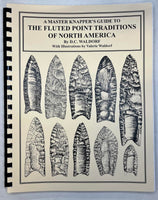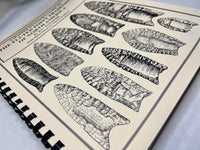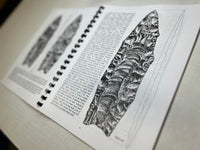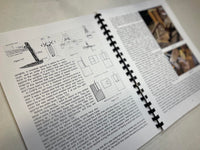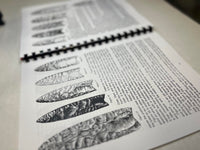Knapper's Guide to Fluted Points - Book 1
D.C. Waldorf artfully presents and analyzes the fluted stone point traditions of North America with this study of famous Folsom, Clovis, and Cumberland points, as well as techniques to create flutes with jigs and other fixtures. The goal of this book is to present illustrations of fluted point specimens that would be useful as guides and templates for modern flint workers and to surround them with an informative text that draws attention to the details that are of most interest to flintknappers, archeologists, and anyone else who appreciates the beauty and function of stone tool technology. Along with this, there is some exploration of the background on the cultures and sites that produced the artifacts.
In first chapter, Cumberland points from the Phil Stratton and Trinity sites are featured along with others. Dates as early as 16,000 years before present, along with new finds have forced a re-examination of the knapping strategies used for Cumberland points. In the next section we find what was originally lumped under the simple Clovis heading has now been divided into at least two periods with the changes in technology used to make Early Clovis points, 13,050 – 12,800 BP, differing from that used to make Late or Post Clovis points passed 12,800 to about 12,000 years BP. Points from many famous sites are examined in detail: the Richey Cache, Lamb, Vail, Sugarloaf and others. Folsom points have long been considered the gold standard of fluted points and early modern knappers strove to discover the secrets of making these thin and delicate pieces. In this section the secrets are revealed which leads into the last chapter which is an overview of fluting techniques, jigs and fixtures that are used by today’s knappers.
8 1/2 x 11, comb bound, 64 pages, with 140 figures/illustrations, over 100 of which are Val’s magnificent line drawings.
In first chapter, Cumberland points from the Phil Stratton and Trinity sites are featured along with others. Dates as early as 16,000 years before present, along with new finds have forced a re-examination of the knapping strategies used for Cumberland points. In the next section we find what was originally lumped under the simple Clovis heading has now been divided into at least two periods with the changes in technology used to make Early Clovis points, 13,050 – 12,800 BP, differing from that used to make Late or Post Clovis points passed 12,800 to about 12,000 years BP. Points from many famous sites are examined in detail: the Richey Cache, Lamb, Vail, Sugarloaf and others. Folsom points have long been considered the gold standard of fluted points and early modern knappers strove to discover the secrets of making these thin and delicate pieces. In this section the secrets are revealed which leads into the last chapter which is an overview of fluting techniques, jigs and fixtures that are used by today’s knappers.
8 1/2 x 11, comb bound, 64 pages, with 140 figures/illustrations, over 100 of which are Val’s magnificent line drawings.







